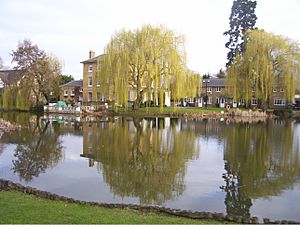River Lynch facts for kids
The River Lynch, also called the Lynch Brook, is a small river in Hoddesdon, Hertfordshire, England. It flows into the River Lea.
Contents
The River Lynch: A Look Back in Time
The River Lynch gets its name from an old word, "lynch." This word described flat, step-like areas built on hillsides. People made these steps, called terraces, to help grow crops. They are similar to the rice terraces you might see in places like South East Asia.
Why Terraces Were Built
These terraces were important because they helped stop soil from washing away. They slowed down the water flowing down the hill. This made the land look like a giant staircase.
Watercress Farming
In the 1800s and early 1900s, these terraces near the River Lynch were used a lot. Farmers grew watercress there. The soil in the valley was very good for this plant. You can still see where these old terraces were today. They are in the Lampits housing area, on the sloping land below the New River.
Ancient Mill and Pond
Close to the terraces, there was a natural hole that brought water up from the ground. This water fed a pond and a watermill. Old records from the Middle Ages mention this pond and mill. They were known locally as 'Le Lince' and were very old even back then.
Changes by the New River
The New River was built to carry water to London. It runs right over the area where the Lynch is. When it was built, it changed a lot of the original landscape. It especially changed places like Lynch Hill and the Lynch Gap.
The River Lynch: Where It Flows
The path of the River Lynch has changed a lot over many years. First, people changed it for farming. Later, it was changed for digging up gravel. The spring that feeds the Lynch also provides clear water to the Admiral's Walk Lake in the Lee Valley Park.
Starting Point and Journey
The Lynch starts behind a property called Spring Lodge in Hoddesdon. After it passes Bridgeways, where the old Lynch Mill used to be, the Woollens Brook joins it.
The river then flows east, going under the Lea Valley railway lines. It continues towards the old Lee Valley Caravan Park near Dobbs Weir. The Lynch then turns south. It flows in a straight channel, forming the western edge of the caravan park. Finally, it joins an old part of the River Lea, which then becomes the Broxbourne Mill Stream, near Dobbs Weir Lock.
Seeing the River Lynch
You can walk next to parts of the River Lynch. There is a public footpath that goes to Dobbs Weir. However, some parts of the river are now inside the gardens of houses along Bridgeways. This is a private road in Hoddesdon.
You can still see and hear the Lynch as you walk along the path. This is especially true where the Woollens Brook joins it, and as it goes under the railway lines.


